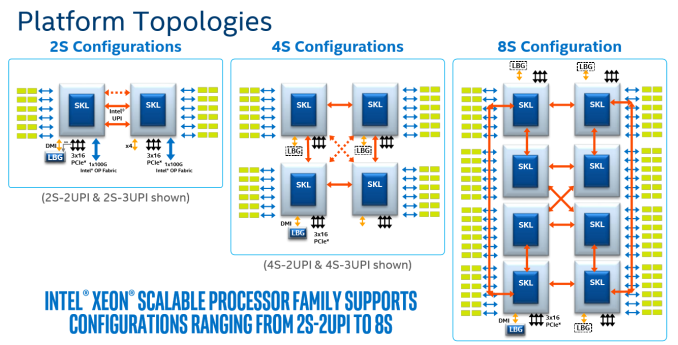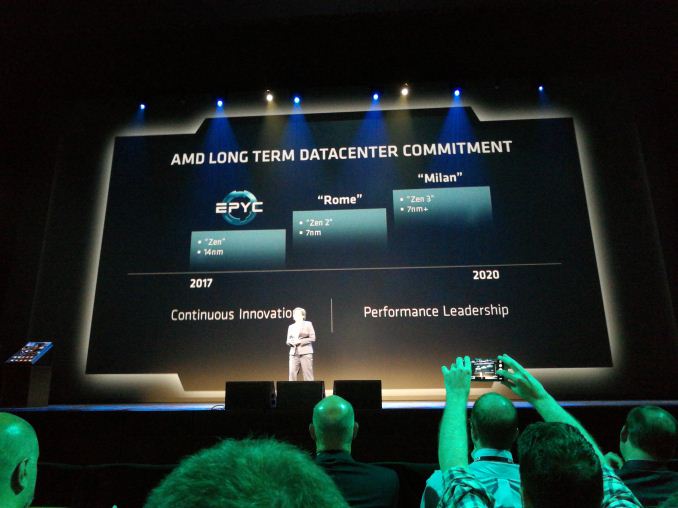Sizing Up Servers: Intel's Skylake-SP Xeon versus AMD's EPYC 7000 - The Server CPU Battle of the Decade?
by Johan De Gelas & Ian Cutress on July 11, 2017 12:15 PM EST- Posted in
- CPUs
- AMD
- Intel
- Xeon
- Enterprise
- Skylake
- Zen
- Naples
- Skylake-SP
- EPYC
Closing Thoughts
First of all, we have to emphasize that we were only able to spend about a week on the AMD server, and about two weeks on the Intel system. With the complexity of both server hardware and especially server software, that is very little time. There is still a lot to test and tune, but the general picture is clear.
We can continue to talk about Intel's excellent mesh topology and AMD strong new Zen architecture, but at the end of the day, the "how" will not matter to infrastructure professionals. Depending on your situation, performance, performance-per-watt, and/or performance-per-dollar are what matters.
The current Intel pricing draws the first line. If performance-per-dollar matters to you, AMD's EPYC pricing is very competitive for a wide range of software applications. With the exception of database software and vectorizable HPC code, AMD's EPYC 7601 ($4200) offers slightly less or slightly better performance than Intel's Xeon 8176 ($8000+). However the real competitor is probably the Xeon 8160, which has 4 (-14%) fewer cores and slightly lower turbo clocks (-100 or -200 MHz). We expect that this CPU will likely offer 15% lower performance, and yet it still costs about $500 more ($4700) than the best EPYC. Of course, everything will depend on the final server system price, but it looks like AMD's new EPYC will put some serious performance-per-dollar pressure on the Intel line.
The Intel chip is indeed able to scale up in 8 sockets systems, but frankly that market is shrinking fast, and dual socket buyers could not care less.
Meanwhile, although we have yet to test it, AMD's single socket offering looks even more attractive. We estimate that a single EPYC 7551P would indeed outperform many of the dual Silver Xeon solutions. Overall the single-socket EPYC gives you about 8 cores more at similar clockspeeds than the 2P Intel, and AMD doesn't require explicit cross socket communication - the server board gets simpler and thus cheaper. For price conscious server buyers, this is an excellent option.
However, if your software is expensive, everything changes. In that case, you care less about the heavy price tags of the Platinum Xeons. For those scenarios, Intel's Skylake-EP Xeons deliver the highest single threaded performance (courtesy of the 3.8 GHz turbo clock), high throughput without much (hardware) tuning, and server managers get the reassurance of Intel's reliable track record. And if you use expensive HPC software, you will probably get the benefits of Intel's beefy AVX 2.0 and/or AVX-512 implementations.
The second consideration is the type of buyer. It is clear that you have to tune more and work harder to get the best performance out of AMD EPYC CPUs. In many ways it is basically a "virtual octal socket" solution. For enterprises with a small infrastructure crew and server hardware on premise, spending time on hardware tuning is not an option most of the time. For the cloud vendors, the knowledge will be available and tuning for EPYC will be a one-time investment. Microsoft is already deploying AMD's EPYC in their Azure Cloud Datacenters.
Looking Towards the Future
Looking towards the future, Intel has the better topology to add more cores in future CPU generations. However AMD's newest core is a formidable opponent. Scalar floating point operations are clearly faster on the AMD core, and integer performance is – at the same clock – on par with Intel's best. The dual CCX layout and quad die setup leave quite a bit of performance on the table, so it will be interesting how much AMD has learned from this when they launch the 7 nm "Rome" successor. Their SKU line-up is still very limited.
All in all, it must be said that AMD executed very well and delivered a new server CPU that can offer competitive performance for a lower price point in some key markets. Server customers with non-scalar sparse matrix HPC and Big Data applications should especially take notice.
As for Intel, the company has delivered a very attractive and well scaling product. But some of the technological advances in Skylake-SP are overshadowed by the heavy price tags and somewhat "over the top" market segmentation.












219 Comments
View All Comments
ddriver - Wednesday, July 12, 2017 - link
LOL, buthurt intel fanboy claims that the only unbiased benchmark in the review is THE MOST biased benchmark in the review, the one that was done entirely for the puprpose to help intel save face.Because if many core servers running 128 gigs of ram are primarily used to run 16 megabyte databases in the real world. That's right!
Beany2013 - Tuesday, July 11, 2017 - link
Sure, test against Ubuntu 17.04 if you only plan to have your server running till January. When it goes end of life. That's not a joke - non LTS Ubuntu released get nine months patches and that's it.https://wiki.ubuntu.com/Releases
16.04 is supported till 2021, it's what will be used in production by people who actually *buy* and *use* servers and as such it's a perfectly representative benchmark for people like me who are looking at dropping six figures on this level of hardware soon and want to see how it performs on...goodness, realistic workloads.
rahvin - Wednesday, July 12, 2017 - link
This is a silly argument. No one running these is going to be running bleeding edge software, compiling special kernels or putting optimizing compiler flags on anything. Enterprise runs on stable verified software and OS's. Your typical Enterprise Linux install is similar to RHEL 6 or 7 or it's variants (some are still running RHEL 5 with a 2.6 kernel!). Both RHEL6 and 7 have kernels that are 5+ years old and if you go with 6 it's closer to 10 year old.Enterprises don't run bleeding edge software or compile with aggressive flags, these things create regressions and difficult to trace bugs that cost time and lots of money. Your average enterprise is going to care about one thing, that's performance/watt running something like a LAMP stack or database on a standard vanilla distribution like RHEL. Any large enterprise is going to take a review like this and use it as data point when they buy a server and put a standard image on it and test their own workloads perf/watt.
Some of the enterprises who are more fault tolerant might run something as bleeding edge as an Ubuntu Server LTS release. This review is a fair review for the expected audience, yes every writer has a little bias but I'd dare you to find it in this article, because the fanboi's on both sides are complaining that indicates how fair the review is.
jjj - Tuesday, July 11, 2017 - link
Do remember that the future is chiplets, even for Intel.The 2 are approaching that a bit differently as AMD had more cost constrains so they went with a 4 cores CCX that can be reused in many different prods.
Highly doubt that AMD ever goes back to a very large die and it's not like Intel could do a monolithic 48 cores on 10nm this year or even next year and that would be even harder in a competitive market. Sure if they had a Cortex A75 like core and a lot less cache, that's another matter but they are so far behind in perf/mm2 that it's hard to even imagine that they can ever be that efficient.
coder543 - Tuesday, July 11, 2017 - link
Never heard the term "chiplet" before. I think AMD has adequately demonstrated the advantages (much higher yield -> lower cost, more than adequate performance), but I haven't heard Intel ever announce that they're planning to do this approach. After the embarrassment that they're experiencing now, maybe they will.Ian Cutress - Tuesday, July 11, 2017 - link
Look up Intel's EMIB. It's an obvious future for that route to take as process nodes get smaller.Threska - Saturday, July 22, 2017 - link
We may see their interposer (like used with their GPUs) technology being used.jeffsci - Tuesday, July 11, 2017 - link
Benchmarking NAMD with pre-compiled binaries is pretty silly. If you can't figure out how to compile it for each every processor of interest, you shouldn't be benchmarking it.CajunArson - Tuesday, July 11, 2017 - link
On top of all that, they couldn't even be bothered to download and install a (completely free) vanilla version that was released this year. Their version of NAMD 2.10 is from *2014*!http://www.ks.uiuc.edu/Development/Download/downlo...
tamalero - Tuesday, July 11, 2017 - link
Do high level servers update their versions constantly?I know that most of the critical stuff, only patch serious vulnerabilities and not update constantly to newer things just because they are available.